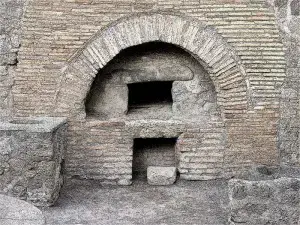Ymullaji
Wood-fired pizza ovens have long been existent for thousands of years. This type of oven has been excavated in ruins of different ancient origins from which it has been known to be popular, probably due to the distinctive savory taste in food it could provide.
Its precursor is the earth oven which is the most simple and historic cooking structure that is still used by some until today, especially in the Pacific region. The earth oven is created using a pit that is made out from the ground and heated with wood and fire prior to cooking. The earliest remains of wood-fire ovens were found in the eastern half of the Mediterranean region which have a beehive shape with a squat clay mound having an internal shelving and an opening at the base for ash removal. What progressed the use of this technology was the Spanish colonizations throughout Europe and Asia.

Oven in the ruins of Pompeii, Italy
Traditional wood-fired ovens are usually constructed out of stonework or other types of aggregates like adobe or cast iron. During Medieval times, usage of ovens have been inventive and had often formed a focal point for communities. This was because only landowners or government authorities had the privilege to have their own ovens for which they lend to other people—similar to present-day laundromats. Communal ovens were put up inside small buildings where people bake bread and pies, cook stews and roast food. The entire village shared the community oven on a rotating schedule usually starting the day with breads before moving on with roasted meals. Apparently, a communal wood-fired oven is still existent in Albury, North South Wales, Australia and was built during 2006 at Hovell Tree Park. This public cooking structure is managed, maintained, funded and offered free by the Albury City Council.

Albury Pizza Oven Coordinator, Michael Laubli
The feudal system of Italy during the Middle Ages was less difficult which allowed families to own wood-fired ovens. These were round, smaller in size, were built from stone or brick and became the foundation of Italy's current pizza industry. Throughout the years, the process of building wood burning ovens advanced and brought out an assortment of modifications from where it actually started.
Pre-assembled pizza ovens marked the renaissance of firewood cooking which took off in the 1970s. After World War II, a lot of wood-fired ovens were destroyed and the electric "American Oven" was created. From here, many families rediscovered wood-fired cooking techniques and made use of the recipes their ancestors had passed down unto them.
A new development in wood-fired oven equipment surfaced around the 1990s, producing modern refractory and insulating materials. Newly designed ovens demonstrated greater fuel efficiency and higher heat retention capacity with only 45 minutes of waiting for the oven to reach the required temperature. Mainstream of ceramic insulation in conventional ovens are now currently present which offered by many manufacturing companies and claim that this is an even greater leap in the pizza oven industry.